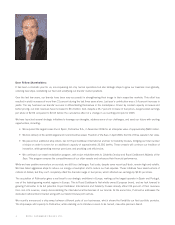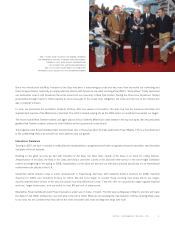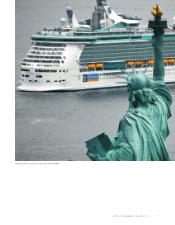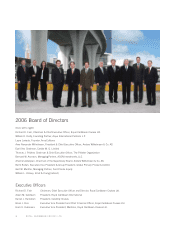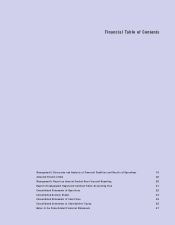Royal Caribbean Cruise Lines 2006 Annual Report Download - page 14
Download and view the complete annual report
Please find page 14 of the 2006 Royal Caribbean Cruise Lines annual report below. You can navigate through the pages in the report by either clicking on the pages listed below, or by using the keyword search tool below to find specific information within the annual report.
Passenger Cruise Days represent the number of passengers carried for
the period multiplied by the number of days of their respective cruises.
OVERVIEW
Our revenues consist of the following items:
Passenger ticket revenues consist of revenue recognized from the sale
of passenger tickets and the sale of air transportation to our ships.
Onboard and other revenues consist primarily of revenues from the
sale of goods and/or services onboard our ships not included in pas-
senger ticket prices, cancellation fees, sales of vacation protection
insurance and pre and post cruise hotel and air packages. Also includ-
ed are revenues we receive from independent third party concession-
aires that pay us a percentage of their revenues in exchange for the
right to provide selected goods and/or services onboard our ships.
Our cruise operating expenses consist of the following items:
Commissions, transportation and other expenses consist of those costs
directly associated with passenger ticket revenues, including travel
agent commissions, air and other transportation expenses, port costs
that vary with passenger head counts and related credit card fees.
Onboard and other expenses consist of the direct costs associated with
onboard and other revenues. These costs include the cost of products
sold onboard our ships, vacation protection insurance premiums, costs
associated with pre and post tours and related credit card fees.
Concession revenues have minimal costs associated with them, as the
costs related to these activities are incurred by the concessionaires.
Payroll and related expenses consist of costs for shipboard personnel.
Food expenses include food costs for both passengers and crew.
Fuel expenses include fuel costs, net of the financial impact of fuel
swap agreements, and fuel delivery costs.
Other operating expenses consist of operating costs such as repairs
and maintenance, port costs that do not vary with passenger head
counts, insurance, entertainment and all other operating costs.
We do not allocate payroll and related costs, food costs, fuel costs
or other operating costs to the expense categories attributable to
passenger ticket revenues or onboard and other revenues since
they are incurred to provide the total cruise vacation experience.
Summary of Historical Results of Operations
We achieved a 3.4% increase in Net Yields in 2006 as compared to
2005, marking the third consecutive year of positive yield growth.
This increase is primarily due to a favorable pricing environment
driven by a positive demand for our products. In contrast, increases
in fuel costs represented a challenge for us again in 2006. Although
price and consumption related initiatives partially mitigated the
increase in fuel costs, fuel expenses on an APCD basis increased
26.7% in 2006 as compared to 2005. As a result, income before the
cumulative effect of a change in accounting principle in 2006
decreased to $633.9 million or $2.94 per share on a fully diluted
basis compared to $663.5 million or $3.03 per share on a fully
diluted basis in 2005.
Highlights for 2006 included:
• Total revenues increased 6.7% to $5.2 billion from total revenues
of $4.9 billion in 2005 primarily due to a 3.5% increase in Gross
Yields and a 3.0% increase in capacity.
• Net Cruise Costs per APCD increased 6.4% compared to 2005
primarily as a result of increases in the cost of fuel and market-
ing, selling and administrative expenses during the year.
• Our Net Debt-to-Capital ratio increased to 46.6% in 2006 from
42.0% in 2005 primarily due to the financing of our acquisition of
Pullmantur. Similarly, our Debt-to-Capital ratio increased to
47.1% in 2006 from 42.8% in 2005.
• We took delivery of
Freedom of the Seas
, Royal Caribbean
International’s first Freedom-class ship, which was financed with
a $570.0 million unsecured term loan.
• We placed three additional ship orders, one for Royal Caribbean
International and two for Celebrity Cruises bringing our total
number of ships on order to six for an additional capacity of
approximately 21,150 berths.
• We acquired Pullmantur in November 2006. For reporting pur-
poses, however, we will be including Pullmantur’s results of oper-
ations on a two-month lag beginning with the first quarter of 2007.
We have included Pullmantur’s balance sheet in our consolidated
balance sheet as of December 31, 2006.
• We called for redemption all of our outstanding zero coupon
convertible notes due May 18, 2021. Most note holders elected
to convert their notes into shares of our common stock rather
than redeem them for cash, resulting in the issuance of approx-
imately 4.1 million shares of our common stock through the end
of the redemption period.
• Under a forward sale agreement relating to an Accelerated Share
Repurchase (“ASR”) transaction, we purchased 4.6 million
shares of our common stock at a price of $35.99 per share. The
ASR transaction was initiated to offset the dilution from the call for
redemption and conversion of our zero coupon convertible notes
into common shares.
• We paid $530.6 million to redeem in full the accreted balance of
our outstanding Liquid Yield Option™ Notes (“LYONs”) due
February 2, 2021.
• We issued at a discount, $900.0 million of senior unsecured notes
to fund the redemption of our LYONs and the ASR transaction.
• We recorded a net gain of $36.0 million resulting from the partial
settlement of a pending lawsuit against Rolls Royce and Alstom
Power Conversion for recurring pod failures on Millennium-class
ships.
Total revenues for 2005 increased 7.6% to $4.9 billion from total
revenues of $4.6 billion in 2004. The increase in total revenues was
primarily as a result of increases in ticket prices. During 2005, Net
Yields increased 7.4% and Net Cruise Costs per APCD increased
6.3% compared to 2004. Gross Cruise Costs increased 6.5% in 2005
compared to 2004 primarily as a result of increases in fuel expenses.
12 ROYAL CARIBBEAN CRUISES LTD.
Management’s Discussion and Analysis of Financial Condition and Results of Operations (Continued)


